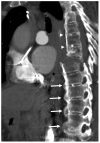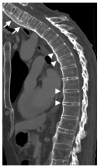Imaging Characteristics of Diffuse Idiopathic Skeletal Hyperostosis: More Than Just Spinal Bony Bridges
- PMID: 36766667
- PMCID: PMC9914876
- DOI: 10.3390/diagnostics13030563
Imaging Characteristics of Diffuse Idiopathic Skeletal Hyperostosis: More Than Just Spinal Bony Bridges
Abstract
Diffuse idiopathic skeletal hyperostosis (DISH) is a systemic condition characterized by new bone formation and enthesopathies of the axial and peripheral skeleton. The pathogenesis of DISH is not well understood, and it is currently considered a non-inflammatory condition with an underlying metabolic derangement. Currently, DISH diagnosis relies on the Resnick and Niwayama criteria, which encompass end-stage disease with an already ankylotic spine. Imaging characterization of the axial and peripheral skeleton in DISH subjects may potentially help identify earlier diagnostic criteria and provide further data for deciphering the general pathogenesis of DISH and new bone formation. In the current review, we aim to summarize and characterize axial and peripheral imaging findings of the skeleton related to DISH, along with their clinical and pathogenetic relevance.
Keywords: CT; DISH; MRI; US; entheses; osteophytes; radiograph; sacroiliac joints; spine.
Conflict of interest statement
The author declares no conflict of interest.
Figures










References
-
- Slonimsky E., Leibushor N., Aharoni D., Lidar M., Eshed I. Pelvic enthesopathy on CT is significantly more prevalent in patients with diffuse idiopathic skeletal hyperostosis (DISH) compared with matched control patients. Clin. Rheumatol. 2015;35:1823–1827. doi: 10.1007/s10067-015-3151-3. - DOI - PubMed
Publication types
LinkOut - more resources
Full Text Sources

